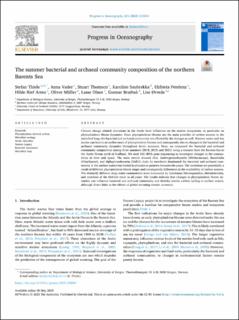| dc.contributor.author | Thiele, Stefan | |
| dc.contributor.author | Vader, Anna | |
| dc.contributor.author | Thomson, Stuart | |
| dc.contributor.author | Saubrekka, Karoline | |
| dc.contributor.author | Petelenz-Kurdziel, Elzbieta Anna | |
| dc.contributor.author | Rief Armo, Hilde | |
| dc.contributor.author | Müller, Oliver | |
| dc.contributor.author | Olsen, Lasse Mork | |
| dc.contributor.author | Bratbak, Gunnar | |
| dc.contributor.author | Øvreås, Lise | |
| dc.date.accessioned | 2023-06-30T08:28:18Z | |
| dc.date.available | 2023-06-30T08:28:18Z | |
| dc.date.created | 2023-06-13T14:39:16Z | |
| dc.date.issued | 2023 | |
| dc.identifier.issn | 0079-6611 | |
| dc.identifier.uri | https://hdl.handle.net/11250/3074653 | |
| dc.description.abstract | Climate change related alterations in the Arctic have influences on the marine ecosystems, in particular on phytoplankton bloom dynamics. Since phytoplankton blooms are the main provider of carbon sources to the microbial loop, the bacterial and archaeal community are affected by the changes as well. Warmer water and less sea ice can lead to an earlier onset of phytoplankton blooms and consequently also to changes in the bacterial and archaeal community dynamics throughout Arctic summers. Here, we compared the bacterial and archaeal community composition during three summers (2018, 2019, and 2021) along a transect from the Barents Sea to the Arctic Ocean north of Svalbard. We used 16S rRNA gene sequencing to investigate changes in the communities in time and space. The main results showed that, Gammaproteobacteria (Nitrincolaceae), Bacteroidia (Polaribacter), and Alphaproteobacteria (SAR11 clade 1a members) dominated the bacterial and archaeal community in the surface waters but varied in abundance patterns between the years. The variations are potentially a result of different phytoplankton bloom stages and consequently differences in the availability of carbon sources. The distinctly different deep water communities were dominated by Candidatus Nitrosopumilus, Marinimicrobia, and members of the SAR324 clade in all years. The results indicate that changes in phytoplankton bloom dynamics can influence bacterial and archaeal community and thereby marine carbon cycling in surface waters, although direct links to the effects of global warming remain uncertain. | en_US |
| dc.language.iso | eng | en_US |
| dc.publisher | Elsevier | en_US |
| dc.rights | Navngivelse 4.0 Internasjonal | * |
| dc.rights.uri | http://creativecommons.org/licenses/by/4.0/deed.no | * |
| dc.title | The summer bacterial and archaeal community composition of the northern Barents Sea | en_US |
| dc.type | Journal article | en_US |
| dc.type | Peer reviewed | en_US |
| dc.description.version | publishedVersion | en_US |
| dc.rights.holder | Copyright 2023 the authors | en_US |
| dc.source.articlenumber | 103054 | en_US |
| cristin.ispublished | true | |
| cristin.fulltext | original | |
| cristin.qualitycode | 1 | |
| dc.identifier.doi | 10.1016/j.pocean.2023.103054 | |
| dc.identifier.cristin | 2154171 | |
| dc.source.journal | Progress in Oceanography | en_US |
| dc.identifier.citation | Progress in Oceanography. 2023, 215, 103054. | en_US |
| dc.source.volume | 215 | en_US |

